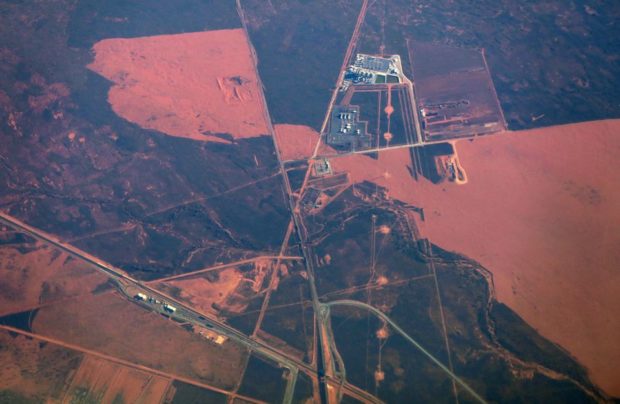
Iron ore mining operations, including a rail network, can be seen in outback Western Australia near the city of Port Hedland in this aerial picture September 5, 2016. REUTERS
SYDNEY — Australia will release on Thursday a state government report on sexual harassment in the country’s mineral-rich west after more than a year of investigations, as the sector tries to fix a culture of sexism and bullying.
Women have long complained of sexual harassment in “fly in, fly out” (FIFO) mining camps.
Major miners including BHP Group, Rio Tinto and Fortescue have made submissions to the inquiry, which is expected to recommend steps to address the issue.
What are mining ‘FIFO’ camps?
Western Australia state is home to the bulk of Australia’s iron ore mines, which account for about half of the world’s iron ore and is a main source of the country’s economic growth.
Mine workers often live in Australian cities, and fly in and out of remote mine sites. They typically live at isolated FIFO camps for a fortnight at a time in West Australia’s mining belt.
Women make up roughly one in five FIFO workers. Critics say the camps have become hubs for alcohol-fuelled behaviour that has created a toxic culture for women and accuse miners of turning a blind eye despite complaints by female employees.
What’s the inquiry about?
A five-member state parliamentary committee, called the Community Development and Justice Standing Committee, conducted the inquiry which is expected to zero in on complaints of sexual harassment at FIFO sites, and investigate how it was handled by miners. The committee will look at:
- if there is a clear understanding of the prevalence, nature, outcomes and reporting of sexual harassment in FIFO workplaces;
- if existing workplace characteristics and practices like cultures, rosters, drug and alcohol policies and recruitment practices adequately protect against sexual harassment;
- if current legislation, regulations, policies and practices are adequate for FIFO workplaces in Western Australia;
- what actions are being taken by industry and government to improve the situation.
What prompted the inquiry?
An Australian Human Rights Commission inquiry into sexual harassment in 2020 found that 74% of women in the mining industry had experienced some form of sexual harassment in the past five years, partly due to the high gender imbalance in the sector.
The sector’s workforce of 150,000 is predominantly – five-sixths – male, a gender mix that’s little improved since its beginnings over a century ago.
Matters came to a head last year as several women reported a culture of bullying and abuse in mining, as well as other Australian workplaces. The revelations sparked public outrage, leading to what has been called Australia’s #MeToo moment.
The outrage also played out in the political sphere as female voters blamed former Prime Minister Scott Morrison for inaction on issues like gender pay gap and violence against women. Morrison was voted out in May.
What has the industry done so far?
In submissions to the inquiry last year, top miners acknowledged that sexual harassment is rife at mining camps in Western Australia, with firms across the industry reporting multiple complaints. BHP, which said it fired 48 staff since 2019, is aiming for 40% female representation across its operations by the end of the 2025 fiscal year.
Rival Rio Tinto published a report in February after conducting an independent review of its own culture, which detailed an environment of bullying, harassment and racism. The review found that nearly 30% of women had experienced sexual harassment at work, with 21 women reporting actual or attempted rape or sexual assault. Rio pledged to adopt all 26 recommendations on improving its workplace culture.
A top mining industry body, the Minerals Council of Australia (MCA), also set out a code for its members to eliminate sexual harassment.
RELATED STORIES
Australia says politicians no longer exempt from sexual harassment rules
Women across Australia march against sexual violence and inequality
Australian megachurch founder denies child sex abuse cover-up
Australia PM will make national apology to sex abuse victims